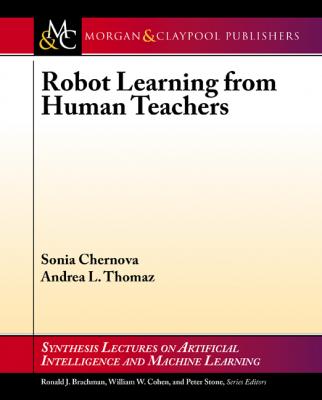Robot Learning from Human Teachers. Sonia Chernova
Читать онлайн.| Название | Robot Learning from Human Teachers |
|---|---|
| Автор произведения | Sonia Chernova |
| Жанр | Компьютерное Железо |
| Серия | Synthesis Lectures on Artificial Intelligence and Machine Learning |
| Издательство | Компьютерное Железо |
| Год выпуска | 0 |
| isbn | 9781681731797 |
KEYWORDS
Learning from Demonstration, imitation learning, Human-robot Interaction
Contents
1.1 Machine Learning for End-Users
1.2 The Learning from Demonstration Pipeline
2.1 Learning is a Part of All Activity
2.2 Teachers Scaffold the Learning Process
2.2.3 Externalizing and Modeling Metacognition
2.3 Role of Communication in Social Learning
2.3.1 Expression Provides Feedback to Guide a Teacher
2.4 Implications for the Design of Robot Learners
3 Modes of Interaction with a Teacher
3.1 The Correspondence Problem
3.5 Design Implications
4 Learning Low-Level Motion Trajectories
4.1 State Spaces for Motion Learning
4.2 Modeling an action with Dynamic Movement Primitives
4.3 Modeling Action with Probabilistic Models
4.4 Techniques for Handling Suboptimal Demonstrations
5.1 State Spaces for High-Level Learning
5.2 Learning a Mapping Function
5.3 Learning a Task Plan
5.4 Learning Task Objectives
5.5 Learning Task Features
5.6 Learning Frame of Reference
5.7 Learning Object Affordances
5.8 Techniques for Handling Suboptimal Demonstrations
5.9 Discussion and Open Challenges
6.1 Batch vs. Incremental Learning
6.2 Reinforcement Learning Based Methods
6.3 Corrective Refinement from the Teacher
6.4 Active Learning
6.4.1 Label Queries
6.4.2 Demonstration Queries
6.4.3 Feature Queries
6.5 Summary
7 Designing and Evaluating an LfD Study
7.1 Experimental Design
7.2 Evaluating the Algorithmic Performance
7.3 Evaluating the Interaction
7.3.1 Subjective Measures
7.3.2 Objective Measures
7.4 Experimental Controls
7.5 Experimental Protocol
7.6 Data Analysis
7.6.1 Choosing the Right Statistical Tool
7.6.2 Drawing Conclusions
7.7 Additional Resources
8 Future Challenges and Opportunities
8.1 Real Users, Real Tasks
8.2 HRI Considerations
8.3 Advancing Learning through Benchmarking and Integration
8.4 Opportunities
8.5 Additional Resources
